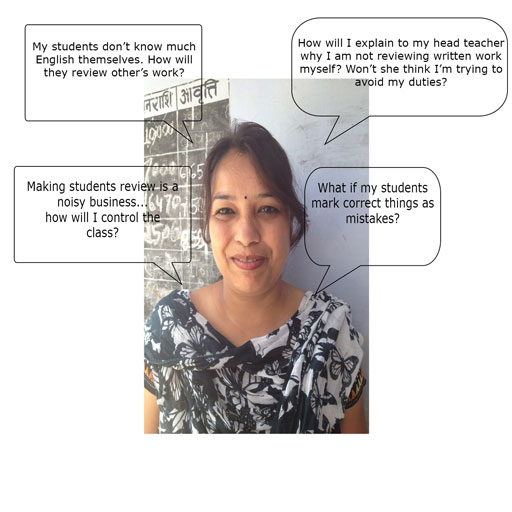3 Using peer review
‘Reviewing’ means reading through written work and finding ways to improve it. It is possible for students to review their own writing, although it can often be difficult for writers to notice their own mistakes and identify areas where they could improve.
One strategy you can use is conducting a peer review, which means getting students to read through and comment on each other’s written work. This has great value because:
- by reading other students’ work, students become more aware of what is required in the task and develop important skills of self-evaluation
- it can be easier to accept observations and suggestions made by a classmate than by a teacher
- classmates may understand the writer’s feelings more, and may be more open with their comments and suggestions
- it can be very motivating for students to read their classmates’ work, and can make students enjoy writing more.
Many teachers are anxious about using peer review. Try Activity 3, which explores some of the issues of using peer review with your students.
Activity 3: Using peer review
This is an activity for you to undertake on your own or with other teachers.
Some teachers, such as Mrs Jadhev in Case Study 2, have many questions about the idea of students reviewing their own work or the work of their classmates. Read Mrs Jadhev’s questions. Are they similar to your own? What answers would you give her? If you can, discuss her questions with a colleague.
Here are some answers given by another teacher. Which of these do you agree with? Read them and see if these would work in your own classroom:
- Correcting classmates’ written work requires students to read the texts carefully. The act of reading is a learning experience for students. Even if they cannot make corrections, they will be able to get a general idea of what is wrong about the passage.
- Involving students in group and pair activities does create a lot of noise, but that happens only the first few times. Once students get into the habit of forming groups for some activity, they settle down quickly.
- Before trying out group review activities, it is a good idea to share the plan with the headteacher. This way, you can get their support and also ask other colleagues to help.
Case Study 3: Mr Rath uses a way to get students to review each other’s written work
Mrs Pallavi Saikia was the headmistress of a secondary school. Last year, when Mrs Saikia recruited a new English teacher, Mr Rath, she found the young man complaining all the time about the amount of corrections he had to do. She decided to demonstrate to Mr Rath and the other English teachers how to get students to review each other’s work. She chose Class VIII, a particularly large and noisy class, and gave them a writing task: ‘What to do when a tsunami warning is announced’ (from the NCERT Class VIII textbook Honeydew). Mr Rath wrote about his experience in his journal.
When the students had composed their texts, Mrs Saikia divided the class into five groups, and gave them names: the Grammarians, the Punctuators, the Content Seekers, the Spell Checkers and the Style Gurus. She also rearranged the classroom so that the members of each group sat facing one another across one desk.
Mrs Saikia announced to the groups that they were her officers, and had to help her review their scripts. The students were very excited. After Mrs Saikia had explained the meanings of the group names, the students understood what they had to do.
She made her instructions clear: the Grammarians had to check each written passage on the Tsunami topic for use of correct grammar, the Punctuators had to check for punctuation mistakes, and so on. Each group had a different job, and when they finished marking their scripts, they had to pass the set to the next group. Mrs Saikia set a rule for the activity that each group had to mark using a different colour, because colour-coding of mistakes would help the writer to realise exactly what category of revision was necessary (grammar, punctuation, etc.).
The students finished this task over three class periods. Mrs Saikia returned the scripts to each writer, and made them sit quietly for ten minutes, reading through the revisions made. She moved around the class, pausing to clarify to students the mistakes made, and helping them to change them accordingly.
I noticed that because of her inventiveness, Mrs Saikia had made a difficult job seem easy. The idea of using interesting group names was what I particularly liked. I realised that Mrs Saikia’s method of getting students to review each other’s work was a very good learning experience for students, and also saved the teacher’s time. I decided to try it out in my own classes.
Activity 4: Try in the classroom – peer review of written work
Next time your students compose a text in English, get them to review their own work, or the work of their classmates. You can do the same as the headteacher in Case Study 3 did, and divide your students into groups that look out for different aspects of writing: grammar, punctuation, spelling, content and style.
An alternative technique is to use a checklist for this (see Resource 3 and the unit Supporting language learning through formative assessment). Write the points on a piece of chart paper and stick it on the wall so that it is always there for the students to see. With this checklist, students can read through each other’s work and make comments about mistakes or things that could be improved.
Once texts have been reviewed, students can exchange their work, and then write a final draft incorporating the comments from their classmates.
Did your students enjoy this activity? What did they learn? How might you improve the activity next time?
2 Making text writing meaningful

